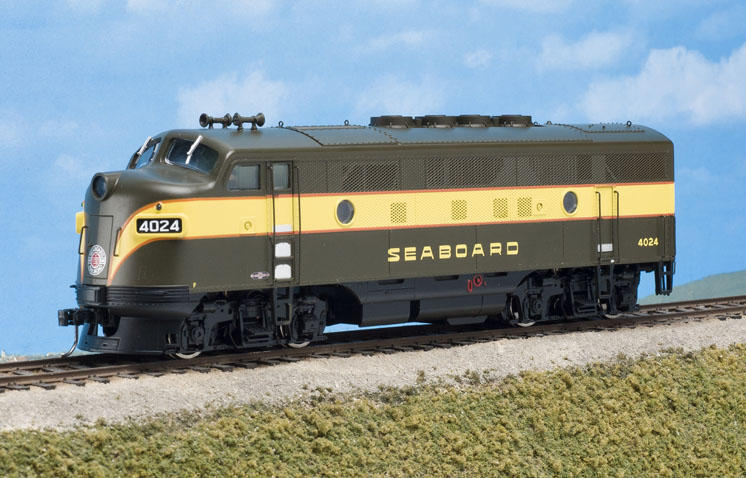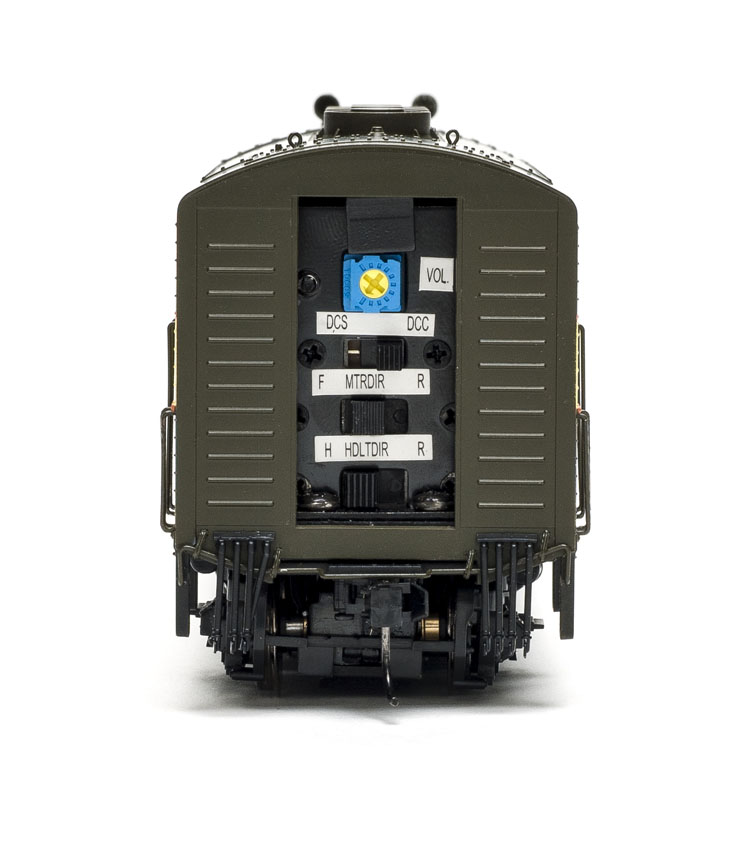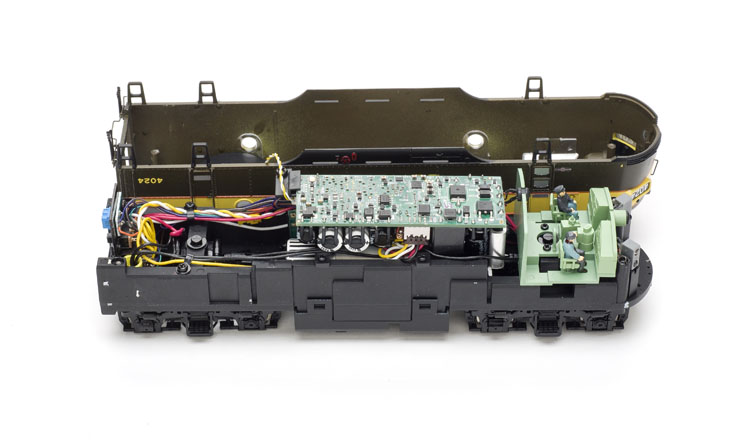A popular Electro-Motive Division F unit is again available in S scale. MTH is releasing its version of the S-Helper Service F3, complete with Proto-Sound 3.0 and full Digital Command System (DCS), Digital Command Control (DCC), alternating-current (AC), and direct-current (DC) capabilities.
The prototype. General Motors built 1,807 F3s, both A and B units, from July 1945 until February 1949. The F3 replaced the FT and F2 in EMD’s catalog. The F2 was an interim model, sharing its electrical components with the earlier FT and an upgraded 16-567B diesel engine and longer frame with the newer F3.
The F3 featured a new generator/alternator that offered better reliability as well as more power, 1,500 hp per unit rather than the 1,350 hp of the earlier models. The new D12 generator also allowed EMD to switch to electrically driven auxiliaries, such as traction motor blowers and radiator fans, in lieu of the belt-driven auxiliaries of the FT.
The model. MTH’s F3 is based on the S-Helper Service F3 from 2006. Upgrades include the MTH Proto-Sound 3.0 control system, allowing operation on MTH’s proprietary Digital Command System.
Switches behind the locomotive’s rear door allow the selection of DCS or DCC, lighting and direction control in DC and AC, and a volume knob to control sound levels. The door and its frame are cleverly held in place with a magnet.
The body shell is a one-piece plastic molding with separately applied details including grab irons, lift rings, windshield wipers, and m.u. hoses. The model comes with American Flyer-compatible couplers and wheelsets, but scale parts are included. Instructions in the owner’s manual detail the switch in a few steps each. [The conversion was also demonstrated in the September 2017 episode of “Cody’s Office,” which subscribers can watch at www.ModelRailroader.com. – Ed.] The front scale coupler was within tolerance for S scale height, but the rear coupler was .032″ too low.
All major dimensions match drawings published in F-units: The Diesels That Did It by Jeff Wilson (Kalmbach Publishing, 2000) and Specifications: General Motors 1500 H.P. “Lead” Unit Diesel-Electric Locomotive (General Motors, 1945).
Our sample unit was decorated for Seaboard Air Lines. The SAL Pullman Green paint and the wide SAL Yellow stripes were smoothly applied and opaque. The orange stripes bordering the wide yellow stripe were translucent and fuzzy around the nose contour.
The model is equipped with dynamic brakes, an option SAL didn’t specify when it ordered 11 F3As for delivery in 1948. MTH also sells a version of the F3A with a steam generator and no dynamic brakes, as well as similarly equipped B units.
MTH’s body shell is the late Phase II style built between December 1947 and July 1948, sporting two porthole windows on each side with wire screens between them and shrouded radiator fans on the roof.
Under the hood. Four screws hold the frame to the body shell. There are also locking tabs at the center of the shell above the fuel tank. Just to be safe, I also removed the couplers and pilot.
Once inside, I found a can motor with flywheels mounted in the center of the die-cast metal frame. All eight wheels are powered and wired to pick up current from the track. The rear flywheel is marked for MTH’s timing system, designed to keep the locomotive operating at the selected speed.
The DCS Proto-Sound 3.0 circuit board is mounted above the motor. Light-emitting diodes (LEDs) illuminate the headlight, classification lights, and number boxes. There’s a separate cab light that comes on with the number boxes when the locomotive is stopped.
The speaker is mounted to the inside of the body shell facing up under the rear radiator fan. A small plug connects the speaker to the wiring harness in the locomotive frame.
On the test track. I started testing the MTH Trains F3A with an NCE PowerCab using DCC. In speed step 1, the locomotive started moving at 4.5 scale mph. It reached a top speed of 68 scale mph in speed step 28.
In addition to the lights, horn, and bell, MTH also includes a “Rev Up” and “Rev Down” feature using F19 and F20. These allow the operator to control the diesel engine sound independently of the locomotive’s speed.
I programmed the locomotive to change its address to the cab number. I also remapped the Rev Up and Rev Down features to different function keys, F7 and F8 respectively, to make them more accessible on the PowerCab.
Function 5 toggles the cab, classification, and number box lights on and off. I was able to control the classification lights separately by creating a function key for them (F4) using MTH’s remapping instructions.
Both tasks were easy to do using programming on the main. MTH discourages using a programming track because the capacitor package on the DCS circuit board interferes with the low-voltage protocol of the programming track. Just make sure you’ve removed any other locomotives with the factory address of 3 before programming on the main.
On direct-current, the start-up sequence played at 6V and the locomotive began moving at just under 2 scale mph at 7V. Top speed at 12V was 58 scale mph, but MTH designs its locomotives to operate on up to 22V. Sound is limited to the diesel engine rpm rising and falling as speed increases and decreases.
I also tested the locomotive using MTH’s DCS system. The locomotive performed well, and it was easier to access the Rev Up and Rev Down functions and to acquire the locomotive. Just remember to set the DCS/DCC switch to the proper mode. I didn’t test the locomotive on alternating current. Classic Toy Trains reviewed the MTH F3A in the September 2017 issue and tested AC operation.
Using an S-Helper Service train set, I created a temporary test track. The locomotive had no trouble negotiating the 20″ radius curves, even when they were assembled into back-to-back S curves. It also negotiated an S-Helper Service no. 3 turnout without incident. With a drawbar pull of 4.8 ounces, the MTH F3 should pull 25 S scale freight cars on straight and level track.
Overall, this is a sharp model. With its modern electronics package, this F3 would make a welcome addition to any transition-era S scale layout.
Price: $379.95, powered A unit with DCS Proto-Sound 3.0; $199.95, non-powered A unit; $359.95, powered B unit with DCS Proto-Sound 3.0; $189.95, non-powered B unit
Manufacturer
M.T.H. Electric Trains
7020 Columbia Gateway Drive
Columbia, MD 21046-1532
www.mthSgaugetrains.com
Era: 1948 to 1966, as decorated for Seaboard Air Line
Roadnames: Seaboard Air Line (A unit only); Atchison, Topeka & Santa Fe; New York Central; Jersey Central Lines; Pennsylvania; Union Pacific (A and B units)
Features
All-wheel-drive and electrical pickup
Die-cast metal chassis
Flywheel-equipped motor
Minimum radius: 20″
Optional S scale couplers and scale wheelsets, in gauge
Digital Command System with Proto-Sound 3.0 sound
Weight: 2 pounds, 1.5 ounces

















